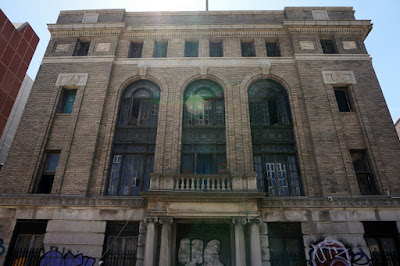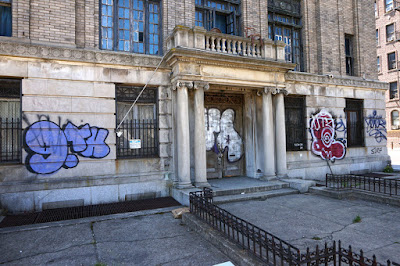 |
| Lipsius - Cook Mansion |
 |
| Lipsius - Cook Mansion |
Address: 670 Bushwick Avenue
Architecture
Built in 1889, the Lipsius - Cook Mansion is a red brick building designed by architect Theobald Engelhardt in the Romanesque Revival style. Engelhardt was a well-known, prolific Brooklyn architect active around the turn of the last century. Some of his other landmarked buildings include three of the Pencil Factory Buildings, Greenpoint Home for the Aged, Northside Savings Bank and William Ulmer Brewery in Bushwick. As an observation, I’d like to note that the Cook Mansion has a very similar spooky quality to the Greenpoint Home for the Aged. The Mansion’s features include a rusticated stone base, terracotta and stone trim, a mansard roof with pilastered dormers and an imposing tower on one corner of the home. Similar to some of Engelhardt’s other buildings, this one has a storied history.
 |
| Lipsius - Cook Mansion Past & Present |
The mansion was originally built for Catherina Claus-Lipsius, owner of the Claus Lipsius Brewing Company that formerly operated at Bushwick Avenue and Forrest Street. The Brewery (also designed by Engelhardt) was one of fourteen breweries on “Brewer Row”. Its claim to fame was for creating the recipe for Brooklyn Lager. A successful business venture, the brewery’s profits allowed Catherine to commission the imposing mansion that she sold to Dr. Frederick Albert Cook in 1902.
 |
| Cover Image from 1909 North Pole Expedition Booklet |
 |
| Photo Claimed by Cook to Show he was the First at the North Pole |
 |
| Dr. Frederick Albert Cook ca. 1906 |
Cook sold the house to an Italian family in 1920 that sold it in 1952 to a Catholic Religious order known as the Daughters of Wisdom. The order used the building as a convent until 1960 when they sold it to a doctor. According to Brownstoner the house was also used as a clinic and was abandoned prior to being repurposed for its current use as a four-unit apartment building.
Sources:
- Brian Merlis & Riccardo Gomes Brooklyn's Bushwick & East Williamsburg Communities Gomerl Publishing, NY 2012
- Kurshan, Virginia "Cathrina Lipsius House (aka Dr. Frederick A. Cook House)" Landmarks Preservation Commission Report 25 June, 2013
- Spellen, Suzanne "Building of the Day: 670 Bushwick Avenue" Brownstoner
- Tietjen, Lib "The Lipsius Cook Mansion" History / Your Story 7 October, 2013
- Hybenova, Katarina "Spooky Mansion on Willoughby Avenue Named a City Landmark" Bushwick Daily 8 July, 2010


